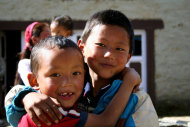The deaths last week of 16 guides in an avalanche on Mount Everest has increased global awareness of the region's close-knit Sherpa community and the risks some of these individuals take when helping climbers ascend the world's tallest peaks.
It's worth noting that the term "Sherpa" does not actually mean "mountain guide," as many people believe, but instead refers to an ancient ethnic community of some 154,000 members.
Most — but not all — of the guides who were killed in the recentEverest avalanche were Sherpas. Others came from one of the dozens of ethnic communities (Tamang, Gurung, etc.) found in the mountain passes and valleys of the Himalayas. [In Photos: Mount Everest Expeditions Then and Now]
What is a Sherpa?
The Sherpas, whose name translates roughly to "Easterners," are settled primarily in the mountainous Solukhumbu region of eastern Nepal, which is also home to Sagarmatha National Park and Mount Everest.
The Khumbu Valley, in the shadow of Mount Everest (which is known locally as Jomolungma, or "Sacred Mother") is inhabited by thousands of Sherpa families.
Most are Buddhists, though some practice Christianity, Hinduism or other religions, according to the Nepal Ethnographic Museum. The Sherpa language is related to other Tibeto-Burman languages spoken in Nepal, Myanmar, China and elsewhere in Asia.
Before they achieved worldwide fame as mountaineers, the Sherpa were primarily known as nomadic cattle herders, high-altitude farmers, weavers and salt traders. (Long a regional staple, Himalayan salt has now achieved worldwide fame among gastronomists who value the mineral for its characteristic pink hue.)
Mountaineering legends
The economy and culture of the Sherpa people changed dramatically in the early 1900s, when mountaineers made Everest the ultimate destination for climbing, ushering in an era of mountain tourism.
Though it was once considered blasphemous to climb a sacred mountain, most Sherpas now regard their role as mountaineering guides with considerable pride.
During the three-month climbing season (which beings in spring), a lead Sherpa guide can earn as much as $6,000, according to the Washington Post. This is a staggering sum to many Nepalis, whose average monthly salary is just $48.
Mountaineering, of course, has many risks, and a safe return home is never guaranteed. According to an Outside magazine analysis of dangerous jobs, miners averaged 25 deaths per 100,000 full-time equivalent employees; U.S. soldiers in Iraq averaged 335 deaths; and Everest guides averaged 1,332 deaths, making mountaineering an even deadlier endeavor than warfare.
It's in their blood
In addition to a tradition of mountain living, the Sherpas may have a physiological anomaly that enables them to live and work at high altitudes longer than other people.
Rasmus Nielsen, a biology professor at the University of California, Berkeley, who has studied the Sherpas' genealogy, has found that they produce fewer oxygen-carrying red blood cells at high altitudes. In contrast, most other people make more of these cells at high altitudes.
This distinguishes the Sherpas from mountain-dwelling groups in the South American Andes and other regions, according to USA Today. Sherpas "seem to function well in high altitude without producing as many red blood cells," Nielsen told USA Today. "No one knows for sure why."
Some of the most famous Sherpa mountaineers include Tenzing Norgay, who in 1953 became one of the first two people (along with Edmund Hillary) to conquer the summit of Mount Everest. In 2011, Apa Sherpa achieved celebrity status by climbing Everest 21 times — a world record.




No comments:
Post a Comment